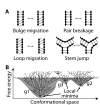Structural dynamics control the MicroRNA maturation pathway
- PMID: 27651454
- PMCID: PMC5175353
- DOI: 10.1093/nar/gkw793
Structural dynamics control the MicroRNA maturation pathway
Abstract
MicroRNAs (miRNAs) are crucial gene expression regulators and first-order suspects in the development and progression of many diseases. Comparative analysis of cancer cell expression data highlights many deregulated miRNAs. Low expression of miR-125a was related to poor breast cancer prognosis. Interestingly, a single nucleotide polymorphism (SNP) in miR-125a was located within a minor allele expressed by breast cancer patients. The SNP is not predicted to affect the ground state structure of the primary transcript or precursor, but neither the precursor nor mature product is detected by RT-qPCR. How this SNP modulates the maturation of miR-125a is poorly understood. Here, building upon a model of RNA dynamics derived from nuclear magnetic resonance studies, we developed a quantitative model enabling the visualization and comparison of networks of transient structures. We observed a high correlation between the distances between networks of variants with that of their respective wild types and their relative degrees of maturation to the latter, suggesting an important role of transient structures in miRNA homeostasis. We classified the human miRNAs according to pairwise distances between their networks of transient structures.
© The Author(s) 2016. Published by Oxford University Press on behalf of Nucleic Acids Research.
Figures





Similar articles
-
Single nucleotide polymorphism associated with mature miR-125a alters the processing of pri-miRNA.Hum Mol Genet. 2007 May 1;16(9):1124-31. doi: 10.1093/hmg/ddm062. Epub 2007 Mar 30. Hum Mol Genet. 2007. PMID: 17400653
-
Sequence variations of microRNAs in human cancer: alterations in predicted secondary structure do not affect processing.Cancer Res. 2006 Jun 15;66(12):6097-104. doi: 10.1158/0008-5472.CAN-06-0537. Cancer Res. 2006. PMID: 16778182
-
Role of pri-miRNA tertiary structure in miR-17~92 miRNA biogenesis.RNA Biol. 2011 Nov-Dec;8(6):1105-14. doi: 10.4161/rna.8.6.17410. Epub 2011 Nov 1. RNA Biol. 2011. PMID: 21955497
-
Regulation of the MIR155 host gene in physiological and pathological processes.Gene. 2013 Dec 10;532(1):1-12. doi: 10.1016/j.gene.2012.12.009. Epub 2012 Dec 14. Gene. 2013. PMID: 23246696 Review.
-
Isolation and identification of gene-specific microRNAs.Methods Mol Biol. 2006;342:313-20. doi: 10.1385/1-59745-123-1:313. Methods Mol Biol. 2006. PMID: 16957385 Review.
Cited by
-
Characterizing micro-to-millisecond chemical exchange in nucleic acids using off-resonance R1ρ relaxation dispersion.Prog Nucl Magn Reson Spectrosc. 2019 Jun-Aug;112-113:55-102. doi: 10.1016/j.pnmrs.2019.05.002. Epub 2019 May 11. Prog Nucl Magn Reson Spectrosc. 2019. PMID: 31481159 Free PMC article. Review.
-
Exosome Carrier Effects; Resistance to Digestion in Phagolysosomes May Assist Transfers to Targeted Cells; II Transfers of miRNAs Are Better Analyzed via Systems Approach as They Do Not Fit Conventional Reductionist Stoichiometric Concepts.Int J Mol Sci. 2022 May 31;23(11):6192. doi: 10.3390/ijms23116192. Int J Mol Sci. 2022. PMID: 35682875 Free PMC article. Review.
-
Pressure pushes tRNALys3 into excited conformational states.Proc Natl Acad Sci U S A. 2023 Jun 27;120(26):e2215556120. doi: 10.1073/pnas.2215556120. Epub 2023 Jun 20. Proc Natl Acad Sci U S A. 2023. PMID: 37339210 Free PMC article.
-
Structure of pre-miR-31 reveals an active role in Dicer processing.bioRxiv [Preprint]. 2023 Jan 3:2023.01.03.519659. doi: 10.1101/2023.01.03.519659. bioRxiv. 2023. Update in: Proc Natl Acad Sci U S A. 2023 Sep 26;120(39):e2300527120. doi: 10.1073/pnas.2300527120. PMID: 36711709 Free PMC article. Updated. Preprint.
-
Alternative RNA Conformations: Companion or Combatant.Genes (Basel). 2022 Oct 23;13(11):1930. doi: 10.3390/genes13111930. Genes (Basel). 2022. PMID: 36360167 Free PMC article. Review.
References
-
- Gralla J., Steitz J.A., Crothers D.M. Direct physical evidence for secondary structure in an isolated fragment of R17 bacteriophage mRNA. Nature. 1974;248:204–208. - PubMed
-
- Mandal M., Breaker R.R. Gene regulation by riboswitches. Nat. Rev. Mol. Cell Biol. 2004;5:451–463. - PubMed
-
- Williamson J.R. Induced fit in RNA-protein recognition. Nat. Struct. Biol. 2000;7:834–837. - PubMed
MeSH terms
Substances
LinkOut - more resources
Full Text Sources
Other Literature Sources

